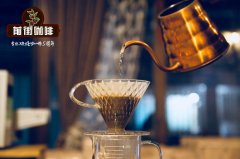The Coffee Story of the four Major producing areas and Manors in Guatemala the reason why Guatemalan coffee is so expensive

Professional coffee knowledge exchange More coffee bean information Please pay attention to coffee workshop (Weixin Official Accounts cafe_style)
Guatemala coffee beans from each region of Guatemala have their own characteristics, which also win a lot of international praise for Guatemala, especially Antigua, how perfectly coordinated its sour, sweet and mellow texture is; add a hint of smoke, emphasize its mystery, and you will have reason not to look for alternatives everywhere after tasting.
Today we continue to visit the four major producing areas and estates of Guatemala...
Guatemala coffee beans are mostly cultivated in volcanic soils at high altitudes, belonging to the highest Arabica variety. Due to the long ripening period, the beans are medium and dense (Guatemala coffee beans are graded not by particle size, but by the number of defects), and the beans are dark turquoise in color. Fragrance, alcohol, sweet balance is its characteristics.
Farrakhan Plateau
The area is volcanic soil, high altitude, abundant rainfall, humidity changes greatly. Ash from Pacaya, Guatemala's most active volcano, provides important minerals for the region's soils. The dry season sunshine is abundant, although the morning fog, dew is big, but dissipates quickly. As a result, Guatemala coffee beans in the region are 100 per cent solarized.
[Features] Bright acidity, consistent, full aroma, delicate body.
[Latisha Manor]
[Country]: Guatemala
[Level: SHB]
[Treatment Plant]: Latisha Manor
Fraijanes, Guatemala City
[Altitude]: 1675 m
[Harvest time]: October to February of next year
[Treatment method]: Washing
[Breed]: Bourbon, Cadura
Flavor: Black tea, floral, rich caramel
Volcanic soil, high altitude, wet and rainy climate, and active volcanic activity create unique geographical conditions in the Farrakhan Plateau region. Pacaya Volcano in this region is the most active of the three active volcanoes in Guatemala, leaving the Farrakhan Plateau often covered in a thin layer of dust and providing sufficient minerals for the Farrakhan Plateau soil. Coffee beans dry during the sun season in the Farrakhan Plateau. Although it tends to be cloudy and foggy in the early morning, it dissipates quickly, ensuring sunny conditions in the area.
The cultivation of Guatemala coffee beans at La Tisha Estate in the Farrakhan Plateau began in 1920. The estate is planted with bourbon, kadura, pacamara, etc., and has a variety of varieties. Of the total area of 205 acres (4046.8 square meters per acre), 173 acres are used for coffee cultivation, and the other 32 acres of native forest are home to various wild species. There are several natural springs on the farm, which provide sufficient and high-quality irrigation for the coffee plantations in the dry season and are also the source of power for the coffee processing plant (water for water treatment).
new Oriental
New Oriental is the newest of Guatemala's major coffee producing regions. In ancient times it was a volcanic area, where the soil is composed of metamorphic rocks, so it is rich in minerals. The New Oriental district was once the poorest part of Guatemala before coffee was grown. Since the 1950s, farmers in the mountains have grown coffee on natural, nutritious land. Gradually, it has become a rising star in Guatemala coffee growing industry.
[Features] The taste is balanced, full-bodied and full of chocolate flavor.
[Guava Plain Manor]
[Country]: Guatemala
[Origin]: New Oriental
[Manor]: Guava Plain Manor
Produced by: Mr. Benjamin Donado
[Treatment method]: Wine fragrance and sun treatment
[Variety]: SL 28
[Altitude]: 1675 m
Flavor: pineapple, dried apricot, red wine
"Guayabo" is a Spanish transliteration, which actually means "plain of guavas". The name is mainly because guavas are really abundant here. The estate is about five hours from the capital of Guatemala and is an impressively dry area. The estate is owned by Mr. Benjamin Donado, who is in his 60s. He started growing coffee in 1990 and has grown from 28 hectares to 72 hectares.
It sounds like nothing special, but it is not as easy as it sounds, because the whole Guayabo coffee farm is built on a steep slope, the lowest altitude is 1400 meters, and then all the way up to more than 1600 meters. Because it is too steep, everyone thinks that it is impossible to grow coffee under such conditions, but Mr. Donado has succeeded in growing remarkable coffee with extraordinary physical strength and great enthusiasm for coffee.
Last year, a small amount of washed SL28 was produced in Guava Plain. This year, under the cooperation with traders, a new batch of sun-dried wine fragrance was added, with unique flavor. When cooperating with traders on this series, we also communicated on the spot about the harvesting standards and sun-dried treatment methods (such as turning and drying days). From the results, it can be said that it is a very happy harvest. Especially SL28 is still rare in Central America.
Traditional Atitlan
Atitlan is one of the five largest volcanic coffee producing areas in Guatemala, and its soil organic matter is the richest of the five volcanic coffee producing areas. 90 per cent of traditional Guatemala coffee beans are grown on the slopes of Lake Atitlan, where intense fire stirs the lake with a daily breeze, an important factor influencing the microclimate of the region. This area has accumulated excellent planting and processing technology for a long time.
Lake Atitlan is a large lake about 1000 feet deep and 140 square miles in area formed by volcanic activity more than 80000 years ago. At dawn, Lake Atitlan, shrouded in morning fog, begins to take on a beautiful blue form as the sun rises. Day-night temperature differences and afternoon winds known as Xocomil are unique microclimates around Lake Atitlan.
[Features] Fresh aroma, bright acidity, full body.
San Marco Volcano
San Marco has the hottest climate of Guatemala's eight coffee-producing regions, with rainfall reaching up to 200 inches (5, 000mm). The rainy season is earlier than in other areas, and coffee trees bloom earlier. As in other remote areas of Guatemala, volcanic San Marco Guatemala coffee beans are grown and processed by small farmers. Due to frequent rains during the rainy season, most coffees are pre-dried in the sun and then dried in Guardiola dryers.
[Characteristics] Aroma and taste have subtle floral fragrance, obvious acidity, good body.
Guatemala Coffee Bean Brand Recommendations
Front Street Coffee roasts Guatemala beans with full guarantees of brand and quality. More importantly, the cost performance is extremely high, a pack of 227 grams, the price is only 118 yuan. According to the calculation of 15 grams of powder per cup of coffee, a pack can make 15 cups of coffee, each cup only costs about 8 yuan, compared with the price of dozens of cups sold in cafes.
Important Notice :
前街咖啡 FrontStreet Coffee has moved to new addredd:
FrontStreet Coffee Address: 315,Donghua East Road,GuangZhou
Tel:020 38364473
- Prev

Guatemala what coffee beans best to drink Guatemala coffee beans characteristics flavor and price list
Professional coffee knowledge exchange More coffee bean information Please pay attention to coffee workshop (Weixin Official Accounts cafe_style) Guatemala Guatemala Guatemala is a coffee producing area that cannot be ignored and a typical representative of coffee flavor diversity. Guatemala coffee beans SHB (hardest beans) is almost universally known as synonymous with high quality coffee. This is because there are more than 300 micro
- Next

Guatemala coffee exactly what characteristics of flavor Guatemala coffee beans how much money a packet?
Professional coffee knowledge exchange More coffee bean information Please pay attention to coffee workshop (Weixin Official Accounts cafe_style) Guatemala coffee beans, produced in Guatemala, Guatemala coffee beans mostly belong to Bourbon species and its varieties of coffee beans, is one of the varieties with strong sour taste, mellow taste and slightly wild, most suitable for blending into mixed coffee. Guatemala coffee beans special
Related
- Does Rose Summer choose Blue, Green or Red? Detailed explanation of Rose Summer Coffee plots and Classification in Panamanian Jade Manor
- What is the difference between the origin, producing area, processing plant, cooperative and manor of coffee beans?
- How fine does the espresso powder fit? how to grind the espresso?
- Sca coffee roasting degree color card coffee roasting degree 8 roasting color values what do you mean?
- The practice of lattes: how to make lattes at home
- Introduction to Indonesian Fine Coffee beans-- Java Coffee producing area of Indonesian Arabica Coffee
- How much will the flavor of light and medium roasted rose summer be expressed? What baking level is rose summer suitable for?
- Introduction to the characteristics of washing, sun-drying or wet-planing coffee commonly used in Mantenin, Indonesia
- Price characteristics of Arabica Coffee Bean Starbucks introduction to Manning Coffee Bean Taste producing area Variety Manor
- What is the authentic Yega flavor? What are the flavor characteristics of the really excellent Yejasuffi coffee beans?

